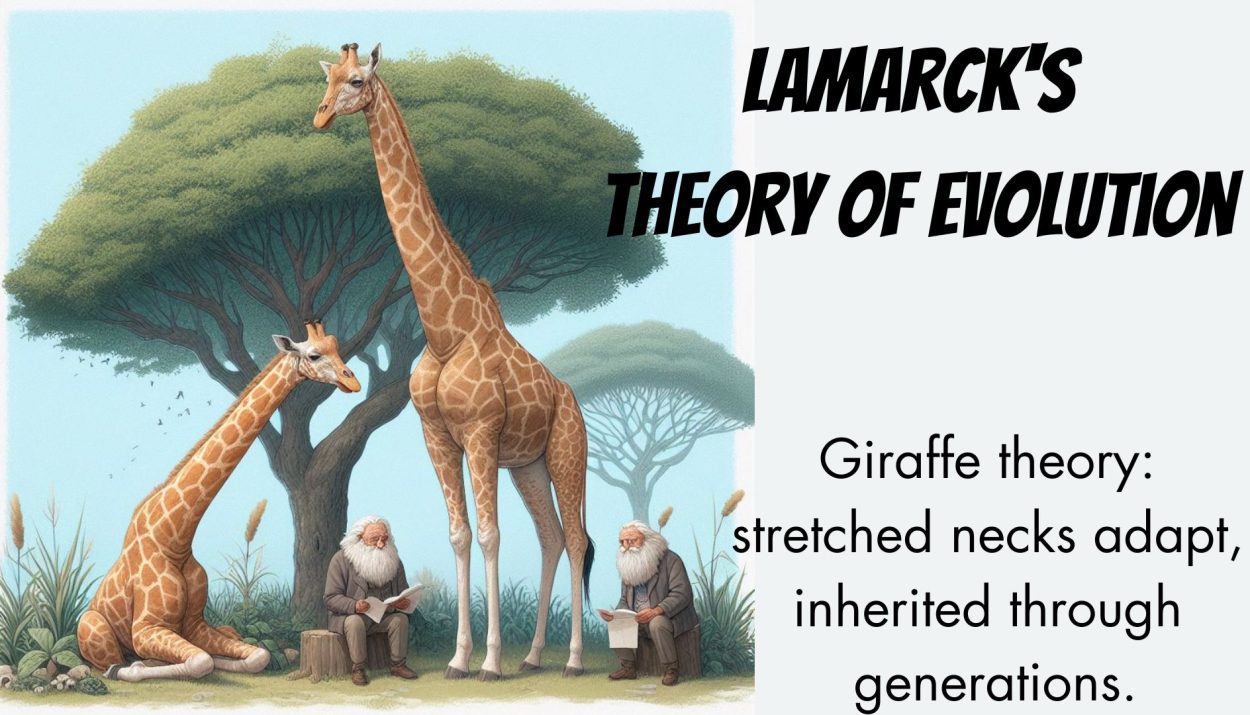In the annals of evolutionary biology, Lamarck’s theory stands as a significant precursor to Charles Darwin’s groundbreaking work on natural selection. Jean-Baptiste Lamarck, an 18th-century French naturalist, proposed a unique perspective on evolution, suggesting that acquired traits during an organism’s lifetime could be inherited by its offspring. While Lamarck’s ideas have been largely overshadowed by Darwin’s more robust theory, understanding Lamarckism sheds light on the historical development of evolutionary thought.
Lamarck’s Theory of Evolution
Lamarck’s theory, commonly known as Lamarckism, is built upon two fundamental principles: the “inheritance of acquired traits” and the “use and disuse” of organs. According to Lamarck, organisms can change during their lifetimes in response to environmental influences, which can be passed down to successive generations.
The concept of the inheritance of acquired traits proposes that an organism acquiring a specific characteristic or trait during its lifetime can transmit this trait to its offspring. This mechanism stands in contrast to Darwinian natural selection, where advantageous traits are favoured over generations through differential survival and reproduction.
Lamarck also introduced the concept of the use and disuse of organs. He posited that organs or body parts actively used become more developed and functional, while those that are not used gradually degenerate over time. This idea was Lamarck’s attempt to elucidate how species might change over time in response to their environments.
In 1809, Lamarck wrote, ‘…so does nature, by means of heat, light, electricity, and humidity, achieve the spontaneous or direct generation of organisms that exist at the beginning of both kingdoms, animal and vegetal, where their most simple forms are to be found’ (as mentioned in the book Outline of Physical Anthropology by B. M. Das). This statement suggests his inclination towards the idea of spontaneous generation of life.
Examples in Support of the Theory
One notable example frequently discussed in the context of Lamarckism is the elongation of the giraffe’s neck. Lamarck suggested that ancestral giraffes had shorter necks because they inhabited regions with shorter trees and vegetation. However, faced with the limited availability of their preferred food, Lamarck proposed that giraffes responded by continuously stretching their necks, adapting to the need to reach higher branches for survival and to better fit their environment. According to his theory, this acquired elongation of the neck was then passed down to subsequent generations, ultimately giving rise to the distinctive long-necked giraffes we observe today.
Birds that began inhabiting aquatic environments slowly developed webbed feet as a survival adaptation, and this trait became hereditary. The Ducks lost their ability to fly as they ceased using their wings for flight, leading to a weakening of the wing muscles.
He argued that the continuous use and development of the arm muscles of blacksmiths in the course of their work could lead to the acquisition of a trait: increased muscular strength that would be passed down to subsequent generations. Numerous instances similar to this can be cited. The existence of certain rudimentary organs, such as the appendix, can also be elucidated by principles akin to those advocated by Lamarck.
Criticism of Lamarckism
Lamarckism, the evolutionary theory proposed by Jean-Baptiste Lamarck, has faced substantial criticism and has largely been replaced by Charles Darwin’s theory of natural selection. Here are some key criticisms of Lamarckism:
One of the fundamental criticisms of Lamarckism is the lack of a known mechanism for the inheritance of acquired traits. Lamarck proposed that traits acquired during an organism’s lifetime could be passed down to offspring, but he did not provide a mechanism for how this information could be transmitted to the next generation. With the discovery of Mendelian genetics, which involves the discrete inheritance of genes, the lack of a clear mechanism in Lamarckism became a significant drawback.
In certain insects such as bees, ants, and wasps, there exist neuter individuals, meaning they cannot pass on environmental modifications as they do not engage in reproduction. Nevertheless, despite this limitation, they display remarkable adaptations to their living conditions and environment. Once more, the exoskeleton of certain advanced insects is so inflexibly structured that alterations in the environment or living conditions are incapable of affecting their external form. When it comes to mammalian teeth, the only conceivable change appears to be a gradual wearing away. It seems illogical to attribute the morphology of teeth, which is adapted to their specific function, to Lamarckian inheritance.
Neo-Lamarckism
It is an adaptation of Lamarck’s original theory, tailored to align more effectively with contemporary knowledge. A cadre of scientists delved deeper into Lamarck’s ‘theory of inheritance,’ forming a collective body of thought known as neo-Lamarckism, proposing that environmental factors could lead to adaptive genetic changes.
This perspective underscored the direct impact of evolving environments on organisms and acknowledged that only modifications affecting germ cells would be transmitted to subsequent generations, aligning with Lamarck’s viewpoints.
Conclusion
While Lamarck’s specific proposals have largely been discredited, his contributions to evolutionary thought should not be overlooked. Lamarckism sparked critical discussions about the possibility of species change over time and the role of the environment in shaping organisms. Moreover, Lamarck’s emphasis on adaptation to the environment and the idea that organisms are not static entities contributed to the broader acceptance of evolution as a concept. It set the stage for later evolutionary theories, including Darwinian natural selection.
References
Book- Physical Anthropology and Human Genetics by B.R.K. Shukla and Sudha Rastogi
Book- Outline of Physical Anthropology by B.M. Das
Jean-Baptiste Lamarck (1744-1829)
